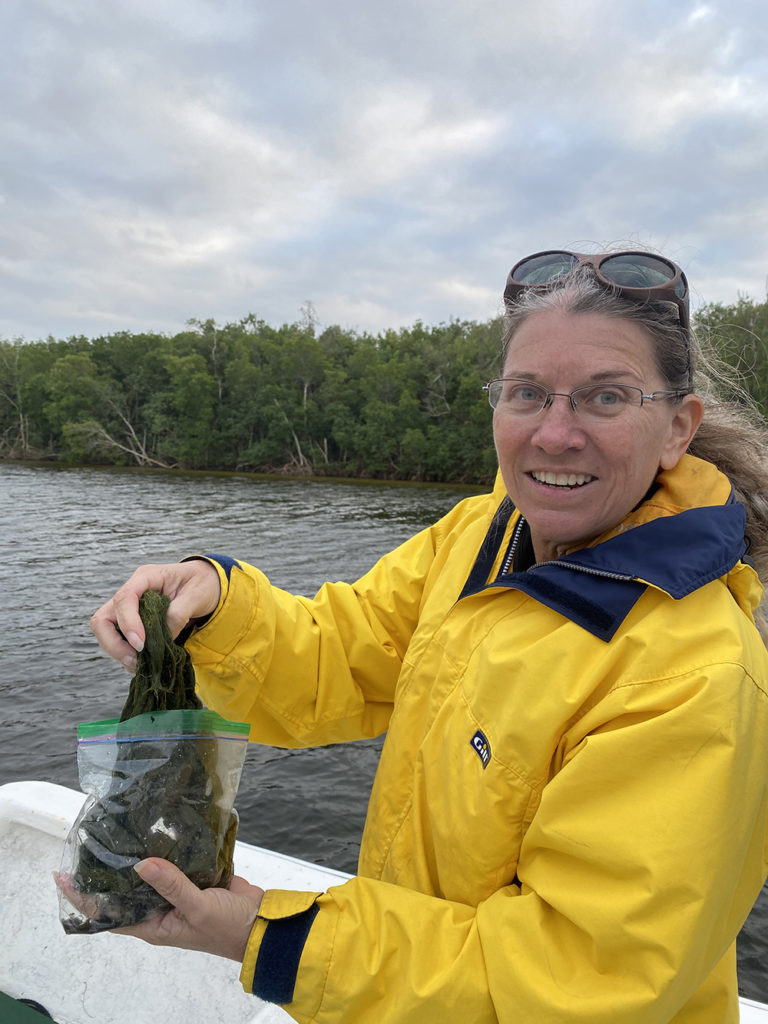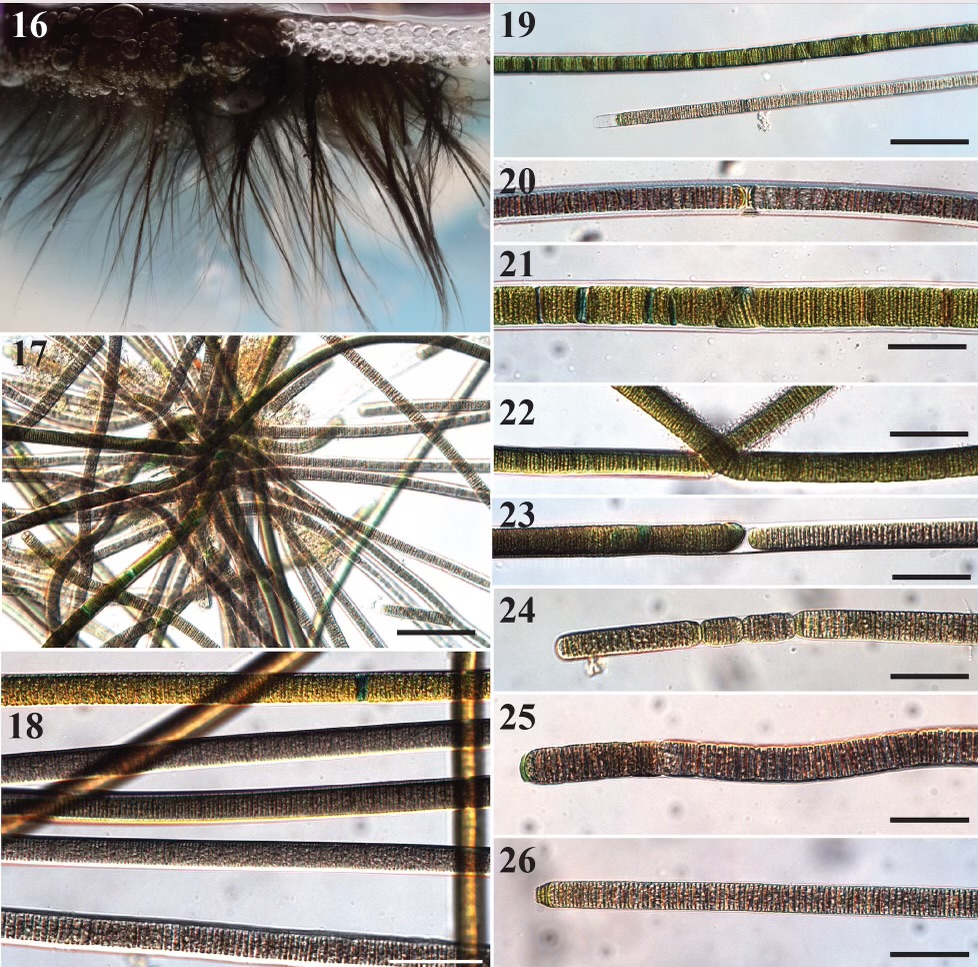
Staugler collecting a macroalgae sample from Charlotte Harbor, Florida. Image courtesy of UF/IFAS.
In celebration of Women’s History Month, Florida Sea Grant proudly highlights Betty Staugler, an individual whose commitment to marine conservation has not only defined her career but also earned her a unique and unexpected honor – the honor of having a newly discovered cyanobacteria named after her.
Sirenicapillaria stauglerae, originating from the Greek and Latin roots meaning “mermaid’s hair,” might seem like a whimsical name for algae. While some suggest it could be linked to the long, wavy locks of Florida Sea Grant’s Elizabeth “Betty” Staugler, it primarily serves as a tribute to Staugler’s steadfast dedication to researching and assessing coastal marine habitats, along with her pivotal role in discovering the algae.
Betty Staugler currently serves as the NOAA Harmful Algal Bloom (HAB) liaison, a Sea Grant/Federal agency initiative funded by the National Sea Grant Office and federal partners from NOAA, and hosted by Florida Sea Grant. The program includes monitoring harmful algal blooms using satellite data and creating short-term and long-term forecasts conducted by NOAA National Centers for Coastal Ocean Science (NCCOS), where she works to obtain stakeholder input on needs and delivery formats.
Staugler works with the NOAA Coast Watch team to develop online video tutorials addressing satellite access, usage, downloading, project integration, and limitations. Her role also involves outreach and education in the national Sea Grant network. She collaborates with states, conducts workshops, and coordinates “HAB chats” to encourage communication and collaboration across the Sea Grant programs.
Before stepping into her current role, Staugler spent an impressive 17 years as a Florida Sea Grant UF/IFAS extension agent in Charlotte County. During this tenure, she established the Eyes on Seagrass program, a citizen science initiative centered around seagrass monitoring. Since becoming the NOAA HAB Liason, Eyes on Seagrass has grown under current Charlotte County Sea Grant agent, Kate Rose. “Betty laid an excellent groundwork for an impactful program that has been rewarding to develop. She continues to be a resource not only for Eyes on Seagrass but for me,” says Rose.
Eyes on Seagrass engages with diverse community members, to conduct surveys of macroalgae lurking in seagrass beds—a matter that resonated strongly among the local fishing guides and anglers.
One such encounter was with Captain Van Hubbard in 2020, a fishing guide in Englewood. Concerned about the severity of the seagrass and macroalgae in his area, Staugler met Captain Hubbard and ventured out onto the water to collect macroalgae samples. The samples were forwarded to Dr. Dail Laughinghouse, an Associate Professor of Applied Phycology and a UF research affiliate of Florida Sea Grant, for identification. Dr. Laughinghouse and his team’s collaboration resulted in the discovery of new species of algae within a unique genus.

Images of Sirenicapillaria sample. Figure 16 shows hair-like thalli, or plant body of the algae. Image courtesy of David E. Berthold.
The naming of Stauglerae is directly inspired by Betty Staugler’s discovery efforts. In contrast, Sirenicapillaria, stemming from the Greek word “Siren” (Greek Σειρήν) and the Latin word “capillus,” meaning hair, refers to the ‘mermaid’s hair’ appearance of these marine cyanobacteria.
“The type of algae named after me is characterized by its thin and dark brown algae composition. The thin strands of this algae appear like hairs that hang down in the water,” says Staugler.
Just as the sound of sirens signals impending danger, sightings of Sirenicapillaria indicate a potential threat.
In 2022, Dr. Laughinghouse and his team published a research manuscript that identifies several varieties of these cyanobacteria including Sirenicapillaria stauglerae. In their scientific manuscript, Dr. Laughinghouse and his team observe that Sirenicapillaria thrives along the western Florida Coast and forms floating mats in the Florida Keys. These cyanobacteria cause significant damage to seagrass beds each year, particularly during the spring and summer months, imposing substantial constraints on local economies and detrimental effects on marine life.
“These algae grow on the seafloor, often attaching themselves to seagrass. As they grow, they create oxygen bubbles. Over time, these bubbles can lift the algae off the seafloor, floating to the surface and decomposing, emitting a strong odor. The decomposition involves bacteria, leading to a hydrogen sulfide smell, triggering citizen complaints, and posing health concerns, ” says Staugler.
While the understanding of this new algal discovery is limited, Betty Staugler emphasizes the significance of current research in uncovering potential threats and informing conservation strategies – all of which would not have been possible without her. Acknowledging Staugler’s pivotal role in facilitating this groundbreaking research, the scientific community paid tribute by naming one of the newfound algae species after her.
“It’s such an unlikelable algae,” jokes Staugler. “But from a scientific perspective, it’s the pinnacle of my career to have something named after me.” She acknowledges the vital role of cyanobacteria, stating, “We owe our life to cyanobacteria, without them, there would be no us. They were the first things to photosynthesize.”
When discussing the potential and challenges for monitoring and forecasting harmful algal blooms, including Sirenicapillaria stauglerae, Staugler expresses an optimistic view.
“Water sampling accurately identifies the type of algae, and satellite imaging exposes the extent of a bloom, improving our sampling strategies and providing advanced warnings of potential impacts,” Staugler emphasizes. “Acknowledging the necessity for higher resolution imagery, new satellites are coming online, and the NOAA team is actively developing new algorithms to meet this requirement.”